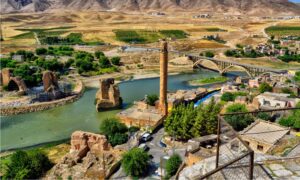A Tough Start
You’d think finding the source of the Tigris would be a walk in the park, but it’s no picnic. Once the dirt road hits a dead-end, you’re on this narrow, sketchy path over a craggy mountain. The way gets even trickier, like a goat’s trail, snaking around until it’s blocked by a bunch of springs. These springs turn into a wild stream that vanishes into a huge cave. When the river finally shows up again 1.5 kilometers later, it’s way more behaved than before, all thanks to whatever happened deep inside that cave.
A Place of Legend
The ancient Assyrians thought this spot was where the real and the spiritual worlds met. Three thousand years back, their big shots went upstream to do some sacrifices. And hey, a carving of Tiglath-Pileser, an Assyrian King from way back when, still stands there. Time’s worn him down, but he’s still standing tall, looking out at his empire.

River’s Journey
The Tigris kicks off in present-day Turkey, zipping southeast out of the Taurus Mountains. It passes through places like Mosul, Tikrit, and Samarra before hitting Baghdad. Down south in Iraq, it meets its partner in crime, the Euphrates, before they both join up and flow into the Persian Gulf.
The Big Deal Zone
Around 8,000 years ago, our ancestors got cozy in the floodplain between these two rivers and kicked off farming and animal wrangling. This area got famous as the “Cradle of Civilisation.” From cities like Eridu and Uruk popped up cool stuff like the wheel and writing. They even laid down laws, made boats, brewed beer, and penned love songs. But with all the trouble in modern Iraq, people kinda forget how important the Tigris has been in shaping our history.
Epic Adventure
I had this wild idea to travel around 2,000 kilometers along the Tigris from its start to where it meets the Persian Gulf. Not many have done that journey since way back in the Ottoman era. My mission? To tell the river’s story through the people living on its shores and check out the threats it faces. Stuff like fights over land, lousy water management, and climate change are putting this once-mighty river in danger. I wanted to remind folks about the birthplace of civilisation that’d be lost if this river dried up.
Amazing Encounters
My team and I saw some incredible sights along the way. From an old Assyrian castle in Turkey to a monastery hanging off a cliff, we soaked in the history. The walls in that monastery still had plaster from the time of Christianity’s early days. It hit me how this river valley became a hotspot for Judaism, Christianity, and Islam to grow and spread their vibes all over.
Hurdles and Kindness
Traveling by boat wasn’t always smooth, especially in Turkey where dam projects made things tricky. In Syria, the river marks the border, but once we hit Mosul, we had a bit more freedom.
Even with all the war stories making headlines, what stuck with me most was how folks treated us with open arms. Even during Ramadan, they’d make tea for us while fasting. One village mayor even shared a story about two young shepherds smuggling people across the river from ISIS territory using a tractor inner tube. No amount of chaos could kill their kindness.
Sacred Moments
We hung out with the Mandaeans, a small religious group in Iraq. They’re big on baptisms in running water, and the Tigris is their jam. Watching their priest do baptisms in the river was something else. They believe this water’s as sacred as it gets.
In a region known for conflict, this journey showed me something different – the river tying together stories of life, death, and incredible acts of kindness. The Tigris isn’t just a boundary; it’s a symbol of human connection.
